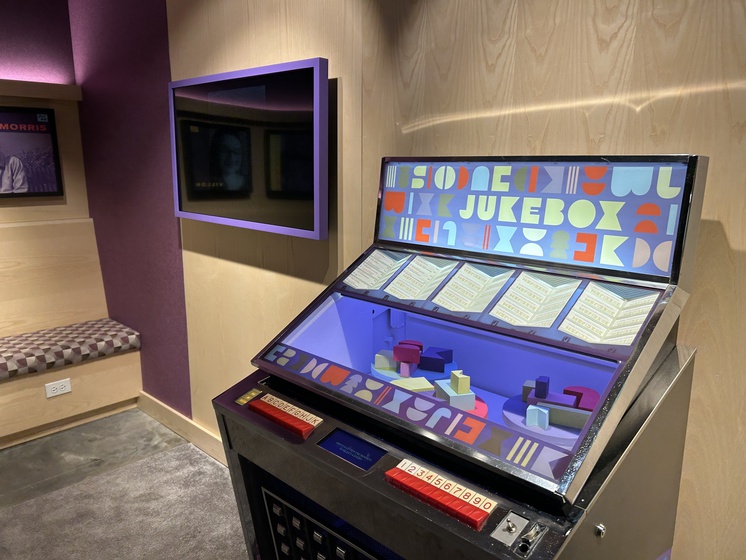{shortcode-4d6ff72ebd77096b2420d388baba9bc51bdd25ba}
I’ve never actually seen a physical jukebox before. Tucked away in a corner of Cambridge’s Foundry, a creative space in Kendall Square, the machine in front of me prompts me to make a selection from its arrangement of letters and numbers.
I press B7 and take a seat on the purple and off-white checkered bench that lines the wall. But it’s not a song that starts playing. It’s the voice of Leon E. Wilson Jr., the president and CEO of the African American History Museum of Boston and Nantucket, sharing the story of how one of his old teachers, Ms. Key, inspired his future academic pursuits.
Next, I click C3. Cambridge attorney Wesley Taylor’s voice fills the room, speaking about his experiences leaving Cambridge — the city his family had lived in for decades — and his decision to eventually return to the place he calls home.
“Cambridge may not be perfect. But I can’t think of any other place that I’d rather live,” Taylor says.
These stories are part of Jukebox, a participatory art project created by Elisa H. Hamilton, who describes herself as a “socially engaged multimedia artist.” Hamilton intends for the project to create a hub for sharing and saving Cambridge residents’ stories, especially those of the city’s residents of color.
She recorded the stories in collaboration with digital storytelling nonprofit The Loop Lab, the Cambridge Public Library, and the Cambridge Black History Project — an organization that studies and spreads awareness about the lives of Black Cambridge residents. The project, which took four years to develop, is funded through Cambridge’s Percent-for-Art Program, which stipulates that 1 percent of the city’s construction costs are used for artwork.
Hamilton’s first step in turning this idea into a reality was acquiring a physical jukebox. After much searching, Hamilton decided to buy a vintage jukebox cabinet — a jukebox without records in it.
“This is a project that is going to exist in public space, potentially forever, we hope, and so, as much as I love records, I really wanted this jukebox to be something that folks could in the future record new stories for and easily swap out the stories without financial barriers,” she says.
To computerize the device, Hamilton worked with an engineer who replaced the jukebox’s internals with a digital system that is easy to use and update — all of the stories are simply stored on a thumb drive.
Once the structure was in place, Hamilton began working on the jukebox’s aesthetics. To preserve the aesthetic of a jukebox, she created sculptures — now seen through its glass screen — that spin when stories are playing. She also hired someone to clean up the body of the machine and made an “album cover” for each story to celebrate the individual who shared it, some of which are framed around the room.
{shortcode-d9be3edeb6b850cacb58e6a4b0bf0a9716c91c20}
“If you look at the website, if you listen to any of the stories, if you visit the Jukebox nook at The Foundry, you’ll notice that there’s a memorable visual identity, and I worked with a graphic designer to realize that identity,” Hamilton says.
She credits her collaborators for the project’s success, saying that while she was “the driver of this project,” she had an “extraordinary” team whom she could not have given life to the project without.
So far, Jukebox has shared 25 stories. Hamilton says she has already recorded 25 more and that her goal is to reach 100. Even after she reaches her goal, though, she hopes that people will continue to share their ideas with each other.
“I really do believe that by sharing stories with each other, we grow to understand ourselves better and we grow to understand the people around us better,” she says.
Jukebox also contains a tale of her own, the first story — A1. Hamilton’s voice echoes through The Foundry with her retelling of why she created Jukebox.
“Jukebox is a story sharing project, not a storytelling project,” she says. “Telling is one-sided, but sharing is something that we can all do together.”


